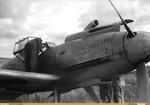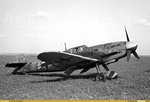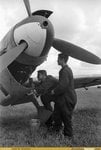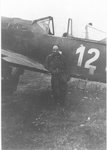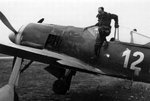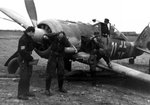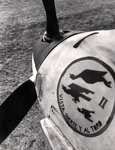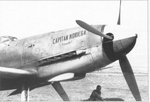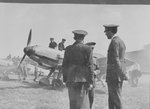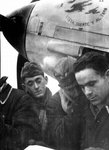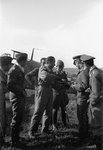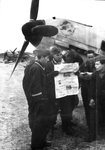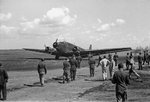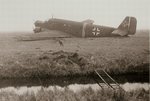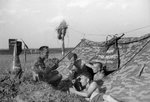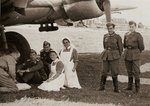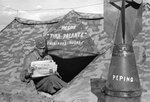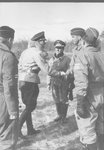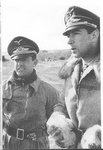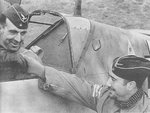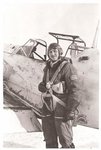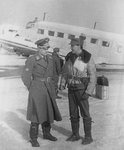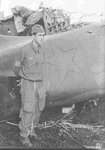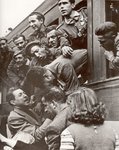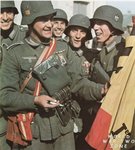The Blue Squadron was a group of voluntary pilots of Spanish Air Force that during World War II fought next to Luftwaffe (Wehrmacht) in In front Russian to the aid of the Germans with his Legion Condor, during Spanish Civil War. In the Luftwaffe it was denominated to them with the name of 15ª Spanische Staffel, added to 27º Group of Caza (JG27), elite unit to the control of Tungsten von Richtofen (old head of the Legion Condor in the Spanish Civil War). In fact she was not a single squadron, but they were five squadrons who went away standing out between 1941 and 1944, every six months approximately, to fight in the Russian front. Its emblem was based on the emblem of Blue Patrol of Joaquin Garci'a-Morato leader of the national fighter aircraft during the Spanish Civil War. In the nose of the Messerschmitt Bf 109 of 1ª Squadron, the mechanics painted the emblem of the fighter group of Garci'a Morato, accompanied now by a two number Roman, in the case of 1ª Squadron (indicating in this way the second fight of the members of the famous unit against the Comunism); by the Cross of Santiago, in 2ª; mounted on the German cross that she identified to the airplanes of the Luftwaffe, in 3ª; superposed on the symbol of the German hunting (she shoots with an arrow winged, surrounded by a crown of laurels) in 4ª; and with a five number Roman (v) in 5ª, placed in the same position that the II of 1ª.
Spanish Air Force was in many aspects better preparation than the rest of the Army to get up itself to the German army, since many of their pilots had flown next to their groups of comrades German of the Legion Condor in 1936-39 and knew the tactics they had taken and them to the practice in innumerable occasions. Some pilots already had flown in the airplanes that were going to them to be given. Spanish aviation hoped to pick up knowledge and formation when forming part of the Luftwaffe, and for this reason relief for the pilots and the expeditionary personnel was constituted when a period of only six months of stay in the front had been completed.
Captain Salas Larrazábal, the right hand of legendary García-Morato, was instructed by the Spanish Department of Aviation (Ministerio del Aire), to command the first Blue Squadron, that left Madrid on July, 24´th 1941 and was trained at the fighter school Warneuchen, near Berlin. The squadron was subordinated to Luftflotte 2, commanded by Generalfeldmarschall von Kesselring. Another member of staff was deputy squadron leader, Captain Muñoz Giménez, who invented the "Kette"-formation, consisting of three planes, used by all actual airforces for ground attacks. The squadron consisted of three captains and twelve lieutenants, all veterans of the Spanish Civil War (7/18/1936 - 4/1/1939). The ground personal was commanded by Ramón Salas, the brother of Captain Salas. On September 24´th, the squadron was transfered to an aerodrom near Moschina, in the southwest of Smolensk, where they got brand new Messerschmitt Bf 109 E (E-4 und E-7) and took off for their first operations to cover german bombers in the area of Viasma. After serveral days, First Lieutenant Alcocer was shot down. The squadron moved to Byelov, at the Moscow-front and later to Kalinin, from where it operated since October 28´th. After that it transfered to Staritza and later, on November 14´th, to Rudsa, 80 km from Moscow. On November 27´th, Captain Muñoz crashlanded on enemy territory.
The following day, the squadron was transferred to airport Klin. It was forced to leave again on December 21´st by motorized Soviet infantry, approaching the base, after the german attack on Moscow was defeated. By early December the squadron also got the new Bf 109 F (F-2 and F-4). It was moved to Duguino and later to Vitebsk, where it was reinforced. On February 7´th, 1942, the squadron got the order to prepare its replacement. General of the Lufwaffe Wilfried von Richthofen decorated the squadrons leader and other officers and soldiers of this Blue Squadron. The squadron downed an total number of 14 russian planes during 422 missions. In the same time, Captain Muñoz, the First Lieutenants Alcocer, Alfonso Ruibal, Ricardo Bartolomé and some more soldiers were killed in action.
Spanish Air Force was in many aspects better preparation than the rest of the Army to get up itself to the German army, since many of their pilots had flown next to their groups of comrades German of the Legion Condor in 1936-39 and knew the tactics they had taken and them to the practice in innumerable occasions. Some pilots already had flown in the airplanes that were going to them to be given. Spanish aviation hoped to pick up knowledge and formation when forming part of the Luftwaffe, and for this reason relief for the pilots and the expeditionary personnel was constituted when a period of only six months of stay in the front had been completed.
Captain Salas Larrazábal, the right hand of legendary García-Morato, was instructed by the Spanish Department of Aviation (Ministerio del Aire), to command the first Blue Squadron, that left Madrid on July, 24´th 1941 and was trained at the fighter school Warneuchen, near Berlin. The squadron was subordinated to Luftflotte 2, commanded by Generalfeldmarschall von Kesselring. Another member of staff was deputy squadron leader, Captain Muñoz Giménez, who invented the "Kette"-formation, consisting of three planes, used by all actual airforces for ground attacks. The squadron consisted of three captains and twelve lieutenants, all veterans of the Spanish Civil War (7/18/1936 - 4/1/1939). The ground personal was commanded by Ramón Salas, the brother of Captain Salas. On September 24´th, the squadron was transfered to an aerodrom near Moschina, in the southwest of Smolensk, where they got brand new Messerschmitt Bf 109 E (E-4 und E-7) and took off for their first operations to cover german bombers in the area of Viasma. After serveral days, First Lieutenant Alcocer was shot down. The squadron moved to Byelov, at the Moscow-front and later to Kalinin, from where it operated since October 28´th. After that it transfered to Staritza and later, on November 14´th, to Rudsa, 80 km from Moscow. On November 27´th, Captain Muñoz crashlanded on enemy territory.
The following day, the squadron was transferred to airport Klin. It was forced to leave again on December 21´st by motorized Soviet infantry, approaching the base, after the german attack on Moscow was defeated. By early December the squadron also got the new Bf 109 F (F-2 and F-4). It was moved to Duguino and later to Vitebsk, where it was reinforced. On February 7´th, 1942, the squadron got the order to prepare its replacement. General of the Lufwaffe Wilfried von Richthofen decorated the squadrons leader and other officers and soldiers of this Blue Squadron. The squadron downed an total number of 14 russian planes during 422 missions. In the same time, Captain Muñoz, the First Lieutenants Alcocer, Alfonso Ruibal, Ricardo Bartolomé and some more soldiers were killed in action.
Attachments
Last edited:

